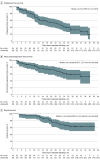High-Dose Aumolertinib for Untreated EGFR-Variant Non-Small Cell Lung Cancer With Brain Metastases: The ACHIEVE Phase 2 Nonrandomized Clinical Trial
- PMID: 40569623
- PMCID: PMC12203398
- DOI: 10.1001/jamaoncol.2025.1779
High-Dose Aumolertinib for Untreated EGFR-Variant Non-Small Cell Lung Cancer With Brain Metastases: The ACHIEVE Phase 2 Nonrandomized Clinical Trial
Abstract
Importance: Central nervous system (CNS) metastases remain a significant challenge in the management of EGFR-variant non-small cell lung cancer (NSCLC).
Objective: To evaluate the activity and safety of high-dose aumolertinib in patients with untreated EGFR-variant NSCLC and brain metastases.
Design, setting, and participants: This was a phase 2 nonrandomized clinical trial conducted at 10 centers in China. Patients with untreated EGFR-variant metastatic NSCLC and brain metastases were enrolled between July 6, 2021, and August 31, 2022. The data cutoff date was October 10, 2024.
Interventions: Patients received aumolertinib, 165 mg, orally once daily until disease progression or unacceptable toxic effects.
Main outcomes and measures: The primary end point was 12-month progression-free survival (PFS) rate assessed by investigators according to the Response Evaluation Criteria In Solid Tumors (RECIST), version 1.1.
Results: A total of 63 patients (39 female [61.9%]; median age, 60 [range, 47-76] years) were enrolled (full analysis set), and 49 had at least 1 measurable brain lesion (CNS evaluable-for-response set). Median follow-up duration was 28.8 months (95% CI, 27.0-29.8). In the full analysis set, the 12-month PFS rate was 62.1% (95% CI, 48.7-73.0), the median PFS was 20.5 months (95% CI, 12.0-26.9), the 12-month intracranial PFS rate was 76.8% (95% CI, 63.2-85.9), and the median intracranial PFS and overall survival were not reached. Systemic and intracranial objective response rates per RECIST 1.1 were 56 of 63 (88.9% [95% CI, 78.4-95.4]) and 52 of 63 (82.5% [95% CI, 70.9-90.9]) in the full analysis set and 43 of 49 (87.8% [95% CI, 75.2-95.4]) and 42 of 49 (85.7% [95% CI, 72.8-94.1]) in the CNS evaluable-for-response set, respectively. The most common grade 3 or 4 treatment-related adverse event was increased blood creatine phosphokinase (17 participants [27.0%]). No treatment-related deaths occurred. EGFR variant clearance in plasma circulating tumor DNA at day 1 of cycle 2 was independently associated with longer PFS (hazard ratio, 0.14 [95% CI, 0.04-0.47]; P = .001).
Conclusions and relevance: The findings of this nonrandomized clinical trial suggest that high-dose aumolertinib is associated with long-term survival benefit in patients with untreated EGFR-variant NSCLC and brain metastases, with a manageable safety profile.
Trial registration: ClinicalTrials.gov Identifier: NCT04808752.
Conflict of interest statement
Figures



Comment on
-
Navigating Selective Dose Intensification in EGFR-Variant Non-Small Cell Lung Cancer.JAMA Oncol. 2025 Aug 1;11(8):908-909. doi: 10.1001/jamaoncol.2025.1768. JAMA Oncol. 2025. PMID: 40569624 No abstract available.
References
-
- Zhou C, Wu YL, Chen G, et al. Erlotinib versus chemotherapy as first-line treatment for patients with advanced EGFR mutation-positive non–small-cell lung cancer (OPTIMAL, CTONG-0802): a multicentre, open-label, randomised, phase 3 study. Lancet Oncol. 2011;12(8):735-742. doi: 10.1016/S1470-2045(11)70184-X - DOI - PubMed
Publication types
MeSH terms
Substances
Associated data
LinkOut - more resources
Full Text Sources
Medical
Research Materials
Miscellaneous

